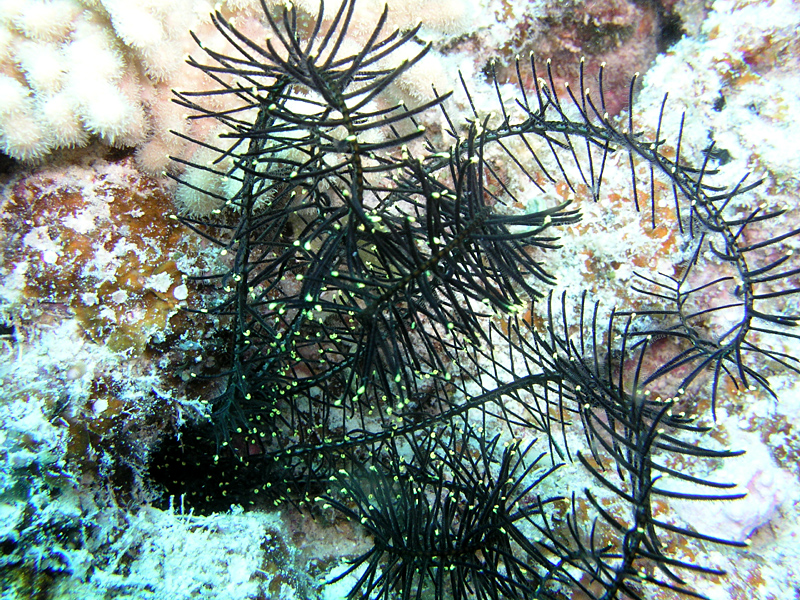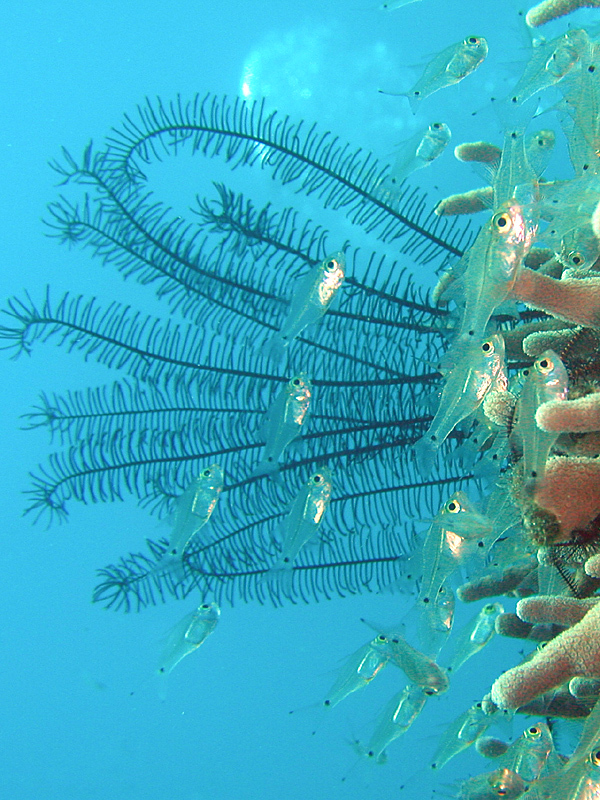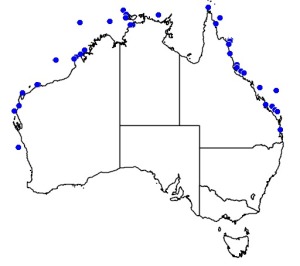
©Lyle Vail and Anne Hoggett: Comanthus gisleni arms protruding from a crevice. Note the longitudinal markings along the arms and yellow pinnule tips.

©Lyle Vail and Anne Hoggett: Feeding tentacles line the pinnules of Comanthus gisleni. This is a close-up of the photo at top of this page.
Colours
Distinguishing features
Comatulids are distinguised from all other featherstar families by having terminal segments of the oral pinnules modified to form a comb. They also have a distinctive "feel" due to well developed hooks on most pinnules that cause them to cling like velcro.
Comanthus gisleni adults have 20 to 30 slender arms which are usually longer on one side of the animal than the other. There are a few weak cirri.
Colour varies widely. Brachials may be black all over, black with irridescent green or yellow flecks, black and yellow forming concentric bands around the animal, dark patched with yellow, or mostly white. Pinnules may be similar or different in colour to the brachials and they often have yellow or orange tips. One feature all specimens seem to have in common is a dark midline on the underside of the arm but this is difficult to see on very dark specimens.
This species is similar to Comanthus parvicirrus. The two can be distinguished in the field on the basis of colour pattern but only if the animal can be extracted from its crevice (Note: a permit it required!). C. gisleni is either uniformly dark or with a dark midline on the proximal brachials on the underside whereas C. parvicirrus has either brown brachials with darker articulations and grey/blue cirri or it is dark green.
Size
- Size data has not been obtained.
Depth range
- Depth range data is not yet available.
Synonyms
Distribution
Distribution and habitat preferences
Comanthus gisleni lives concealed under rubble or within the reef, usually with with a few arms protruding from a crevice for feeding. They emerge further at night (Vail, 1987) but the disc always remains concealed.
Comanthus gisleni can be found almost everywhere around the Lizard Island group. It is common on the reef slopes and is also found in the lagoon and back reef areas.
Web resources
References
References that assist with identification
- Rowe, F.W.E., A.K. Hoggett, R.A. Birtles and L.L. Vail (1986). Revision of some comasterid general from Australia (Echinodermata: Crinoidea), with descriptions of two new genera and nine new species, Zoological Journal of the Linnean Society, 86: 197-277. LIRS catalog number 198.
- Summers, M. M., C.G. Messing and G.W. Rouse (2014). Phylogeny of Comatulidae (Echinodermata: Crinoidea: Comatulida): A new classification and an assessment of morphological characters for crinoid taxonomy, Molecular Phylogenetics and Evolution, 80: 319-339. LIRS catalog number 1813.
Other references
- Rouse, G.W., L.S. Jermiin, N.G Wilson, I. Eeckhaut, D. Lanterbecq, T. Oji, C.M. Young, T. Browning, P. Cisternas, L.E. Helgen, M. Stuckey and C.G. Messing (2013). Fixed, free, and fixed: The fickle phylogeny of extant Crinoidea (Echinodermata) and their Permian - Triassic origin. Molecular Phylogenetics and Evolution, 66: 161-181. LIRS catalog number 1601.
- View all references







